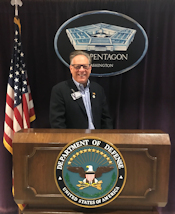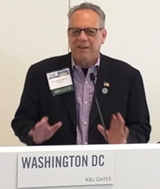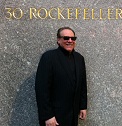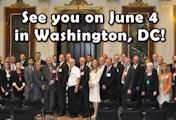NanoBusiness Interview Series – Hart and Warwick of NanoInk
Posted on May 11th, 2012 in Uncategorized | No Comments »
I enjoy seeing companies in our Nanotechnology community succeed. I first met NanoInk 12 years ago when I worked at Red Herring Magazine. It is amazing to see what they have achieved. Today, we continue our Interview Series with two leaders from NanoInk: Dean Hart, Chief Commercial Officer and Tom Warwick, General Manager. Last week I was in Portland, OR for the NNI 2012 RSL Workshop http://www.nano.gov/node/732 and had an opportunity to speak with Dean Hart. I commend Dean and Tom for their commitment and contributions to our Nanotechnology community. Howard Lovy, noted Nanotechnology writer conducted today’s interview.
NanoInk, a nanotech company based in Chicago, is breaking down at least two barriers that stand in the way of widespread nanotech commercialization – getting the tools of the future nanotech trade in the hands of companies rather than researchers, and training a new generation of workers in how to use them.
Dean Hart, Chief Commercial Officer in charge of the NanoProfessor division is handling the training portion, while Tom Warwick, General Manager for NanoInk’s NanoFabrication Systems division, is selling the idea of nanofabrication to companies that could use it to create their next-generation products. Together, they just might help push nanotech into the mainstream.
First, let’s meet Hart and the NanoProfessor educational program he is marketing for NanoInk. Early in 2009, Hart says, NanoInk had just launched a desktop version of a product called the NLP 2000, a nanolithography instrument. It caught the attention of Deb Newberry, Director of the Nanoscience Technology program at Dakota County Technical College in Rosemount, MN. She was looking for a way for her students to get the training they need on a real-life nanotech instrument – not a simulation. “What you have here is the cornerstone of a hands-on educational program,” Newberry told NanoInk, according to Hart.
Also, said Hart, as nanotech was moving from research to commercialization, there was still a knowledge gap preventing its total emergence. The only people who had experience with nanotech, and use of nanotech tools, were Ph.D.s and postdocs – primarily doing research. “The big question is who’s going to do the work?” Hart said. “You cannot build an industry, nor can you build a company, on the backs of Ph.D.s. It doesn’t scale.
“One of the greatest obstacles facing the commercialization of nanotechnology today is that there is not a nano-savvy workforce readily available.”
NanoInk had batted around the idea of an educational program before as part of a general discussion on how to diversify, but now the concept was validated. “We have the instrument, we have the need. Let’s build it,” Hart said.
As an example of a successful workforce education program, Hart points to Albany, NY, where undergraduates are being trained for the semiconductor industry. Investment in education is paying off as more semiconductor companies move to Albany because that is where the talent is located.
In North Carolina, he said, Forsyth Technical Community College in Winston-Salem is able to help align the future workforce with what the community needs – undergrads who are well-versed in nanotech and biotech. As a result, Forsyth is getting the talent pool ready for Research Triangle Park, where pharmaceutical companies are ready with jobs.
Another example, Hart said, is North Central State College in Mansfield, OH, which is looking at providing the workforce for a new proliferation of biopharmaceutical and bionanotech companies. They’re looking at implementing the NanoProfessor program.
Hart recently heard from Indian River State College in Fort Pierce, FL, where the Brown Center for Innovation and Entrepreneurship is looking at the NanoProfessor suite for their nanotechnology and applied sciences lab. The program is looking at how to maximize thin film to increase the productivity of solar energy, along with food additives that can detect spoilage. It’s all centralized around nanotech and applied science.
And the training program does not require a cleanroom – just an average-sized lab. All the equipment is “research-grade,” nothing dumbed down and no simulations or models used.
The NanoProfessor program itself involves six chapters in a 300-plus-page textbook written specifically for undergraduate students. The main topics involve nanobiology, nanochemistry and nanophysics, with brief reviews of traditional sciences. NanoProfessor contains 11 labs, with the NLP 2000 as the centerpiece. “That’s the game-changer,” Hart said. “That allows these students to actually build nanoscale structures in a desktop setting using metallic nanoparticles or biologic agents.”
Tools also include an atomic force microscope so they can see what they are building, also a nanoflourescence microscope to drive biological applications and a nanoparticle characterization tool allows students to get inside nanoparticles. The skills students are learning through NanoProfessor include fabrication, imaging and characterization. One of the labs involves building a DNA array between of between 1 and 2 microns. In the industry, DNA arrays are typically 100 to 300 microns, Hart said. So, they are learning state-of-the-art fabrication techniques.
“We’re not just teaching them how to operate the tools, we’re teaching them skills that can translate to any type of job,” including servicing the equipment and lab technician, he said.
So, this is not a tough sell. What is tough, though, is for schools to find funding to purchase the system, which runs in the ballpark of $300,000 or less.
“Honestly, one of the concerning points for us is there seems to be, at least from a funding perspective, much greater access to funds internationally than there is in the United States,” Hart said.
That is why NanoProfessor is having slightly more success internationally. Hart said they had just sold five systems in Sao Paulo, Brazil, with five to 10 more in demand before the end of the year. Colombia has eight of their systems, and there is interest everywhere from Turkey to China to India. It’s a competition for worker training that the United States could end up losing if it does not reorganize its priorities.
“We continue to invest in research, which is extremely important, whereas the rest of the world takes that research and then they start investing in the workforce that’s going to be able to implement it,” Hart said.
In Suzhou, China, for example, they’re launching what they are calling the Nano-Polis project that will train 30,000 workers in nanotechnology. It is a commitment to taking research and turning it into workforce development that Hart does not see happening so far in the United States.
The solution, he said, is for commercial companies to approach their local undergraduate institutions and tell them that they need their help in building the new nanotech-enabled workforce. Companies cannot pay too many $90,000-a-year Ph.D.s, but they can hire educated, nano-savvy employees at $50,000 a year. Do that, and “the whole business model has changed,” he said.
It’s about getting the technology to the attention of the masses, training them, opening up their minds to what is available, he said. “We have an opportunity for leadership, but if we don’t act quickly we’re going to lose it.”
To date, Hart said, NanoProfessor has sold 25 systems and could end the year with anywhere between 40 to 50 additional systems sold.
While Hart is helping to prepare the future nanotech workforce, Warwick is helping to transition nanotech out of the academic lab and into the commercial world. And he sees immediate opportunity in biotech. When Warwick joined the company about three years ago, NanoInk had a number of tools that were largely aimed at life scientists for their chemistry or nanoengineering labs.
Warwick set off on a continuing mission to show biotech companies that they can benefit, too. They’ve been featuring substrates on which you can grow living cells, then treat each row to a different drug at different concentrations. The goal is immediate, point-of-care diagnostics, and Warwick said NanoInk is attracting attention from biotech companies large and small.
Warwick has been hitting the road a great deal these days, armed with stacks of proof-of-concept data.
“What I do love about what I’m doing is whenever we present, people smile and they nod their heads and their eyes glisten and gleam with excitement and say, ‘Wow, I just didn’t realize you could do that.'”
Warwick is finding interest from Fortune 50 companies and is active in India. “They are investing heavily in nanotech,” Warwick said.
Warwick has long played the role of the guy who could take research lab tools and transition them into the commercial marketplace. Back in 1993 in the U.K., he was with a company that made ultra-high-vacuum scanning tunneling microscopes. He was their first commercial person and doubled sales in the first year. In the second year, he doubled them again. The business was eventually sold to Oxford Instruments.
Next, he set up Digital Instruments, an AFM company that eventually merged with Veeco, where he became European Sales and Global Sales Vice President at the same time. “I was working 18-hour days and loving it,” he said.
So, it was with this experience in mind that NanoInk took him on to help lead the company to the next phase of commercialization. The toughest part of his job is simply the disruptive nature of the products he is selling. When he first came to the United States from the U.K., Warwick thought it would be easier, since the U.S. is investing heavily in nanotech.
“But it is a technology where people are saying, ‘Well, do I really want to be first or can I manage without in the short term?'”
And when he’s talking to biosensor startups, they’re just bulk-coating materials for proof-of-concept. “So, they’re getting away with the quick and dirty while they’re working on what’s next, which will be multiple materials on their sensor device.”
But, Warwick said, the message is getting through as established companies and startups look to create the next phase of the the biotech revolution – which will be field-based, point-of-care products. They will need the tools that NanoInk can offer to create multiplexing materials into the mobile industry.
Both Warwick and Hart say it’s a good time to be doing what they’re doing, creating the infrastructure necessary for what’s next in nanotech.
“It’s amazing how big companies are approaching us, looking for new technology,” Warwick said. It is an exciting time. It’s a new phase. It was academics, small startups, but also large companies are very interested in point-of-care diagnostics.”
NANO NEWS
The Challenge: Boost Nano, Create Jobs
http://www.newhavenindependent.org/index.php/archives/entry/the_challenge_boost_nano_create_jobs/id_46960
PCAST Documents & Reports
2012 Nanotechnology Report
http://www.whitehouse.gov/administration/eop/ostp/pcast/docsreports
I would like to thank Dean Hart and Tom Warwick for taking the time to share their opinions for our Nanotechnology community.
Regards,
Vincent Caprio “Serving the Nanotechnology Community for Over a Decade”
Executive Director
NanoBusiness Commercialization Association
203-733-1949
vincent@nanobca.org
www.nanobca.org
www.vincentcaprio.org




